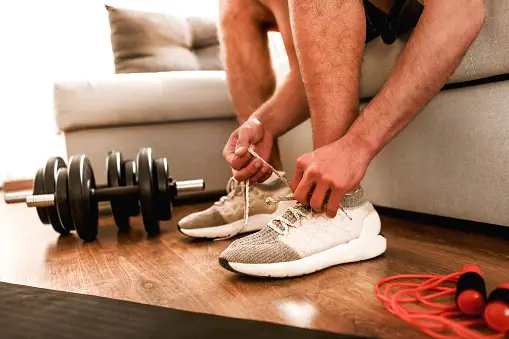Regular exercise is a cornerstone of a healthy lifestyle. The benefits of physical activity extend far beyond weight management. It contributes to mental well-being, reduces the risk of chronic diseases, improves mood, and enhances overall quality of life. This article delves into the importance of regular exercise, explores its multifaceted benefits, and provides a comprehensive guide on how to get started with an exercise routine that suits your needs and lifestyle.
The Importance of Regular Exercise
Physical Health Benefits
- Cardiovascular Health
- Regular exercise strengthens the heart muscle, improving its ability to pump blood efficiently. This reduces the risk of cardiovascular diseases such as heart attack, stroke, and hypertension.
- Aerobic exercises like walking, running, swimming, and cycling enhance cardiovascular endurance and lower blood pressure and cholesterol levels.
- Weight Management
- Physical activity burns calories, aiding in weight loss and preventing obesity. It helps to maintain a healthy weight by balancing the number of calories consumed with the number burned.
- Combining exercise with a balanced diet creates a sustainable way to achieve and maintain an optimal weight.
- Muscle and Bone Health
- Weight-bearing exercises such as weightlifting, resistance training, and bodyweight exercises increase muscle mass, strength, and endurance.
- These activities also promote bone density, reducing the risk of osteoporosis and fractures, especially in older adults.
- Chronic Disease Prevention
- Regular physical activity lowers the risk of developing chronic diseases such as type 2 diabetes, metabolic syndrome, certain cancers, and respiratory conditions.
- Exercise enhances insulin sensitivity and glucose metabolism, making it a critical component in managing and preventing diabetes.
Mental Health Benefits
- Improved Mood and Mental Health
- Exercise stimulates the release of endorphins, serotonin, and dopamine, chemicals in the brain that promote feelings of happiness and reduce symptoms of depression and anxiety.
- Physical activity can be a powerful tool for managing stress, improving sleep quality, and enhancing overall emotional well-being.
- Cognitive Function
- Regular exercise is linked to better brain health, including improved memory, attention, and processing speed.
- Physical activity promotes neurogenesis, the growth of new neurons, and improves blood flow to the brain, which may protect against cognitive decline and neurodegenerative diseases like Alzheimer’s.
Social and Lifestyle Benefits
- Social Interaction
- Participating in group sports, fitness classes, or recreational activities fosters social connections and a sense of community.
- Social interaction through exercises can provide support, motivation, and accountability, making it easier to stick to a fitness routine.
- Enhanced Quality of Life
- Regular physical activity improves energy levels, reduces fatigue, and enhances the ability to perform daily tasks with ease.
- It promotes a sense of accomplishment, boosts self-esteem, and can contribute to a more active and fulfilling lifestyle.
Getting Started with Regular Exercise
Assessing Your Fitness Level
- Consulting a Healthcare Professional
- Before starting any exercise program, it’s advisable to consult with a healthcare professional, especially if you have existing health conditions or concerns.
- A healthcare provider can help assess your fitness level, recommend appropriate activities, and identify any limitations.
- Setting Realistic Goals
- Establish clear, achievable goals based on your current fitness level and desired outcomes. Goals should be specific, measurable, attainable, relevant, and time-bound (SMART).
- Consider short-term and long-term goals to stay motivated and track progress.
Choosing the Right Exercise
- Types of Exercise
- Aerobic Exercise: Activities like walking, jogging, cycling, swimming, and dancing that increase heart rate and improve cardiovascular endurance.
- Strength Training: Exercises such as weightlifting, resistance band workouts, and bodyweight exercises that build muscle mass and strength.
- Flexibility and Balance: Yoga, Pilates, and stretching exercises that enhance flexibility, balance, and posture.
- Personal Preferences and Lifestyle
- Choose activities that you enjoy and that fit into your lifestyle. Enjoyable exercises are more likely to become a regular part of your routine.
- Consider factors like time availability, access to facilities, and whether you prefer exercising alone or with others.
Creating an Exercise Plan
- Frequency, Intensity, Time, and Type (FITT Principle)
- Frequency: Aim for at least 150 minutes of moderate-intensity aerobic activity or 75 minutes of vigorous-intensity activity per week, combined with muscle-strengthening activities on two or more days a week.
- Intensity: Start with moderate-intensity activities and gradually increase intensity as your fitness level improves.
- Time: Begin with shorter sessions and gradually increase the duration as your endurance builds.
- Type: Incorporate a variety of exercises to target different muscle groups and prevent boredom.
- Progression and Variety
- Gradually increase the intensity, duration, and frequency of your workouts to continue making progress and avoid plateaus.
- Incorporate different types of exercises to keep your routine interesting and to challenge your body in new ways.
Staying Motivated
- Tracking Progress
- Keep a workout journal or use a fitness app to track your activities, progress, and achievements.
- Regularly review your goals and celebrate milestones to stay motivated.
- Finding a Support System
- Engage friends, family, or workout partners who can provide encouragement and accountability.
- Join fitness classes, sports teams, or online communities to connect with others who share similar goals.
- Overcoming Obstacles
- Identify potential barriers to exercise and develop strategies to overcome them, such as time management, setting priorities, and finding convenient workout options.
- Be flexible and adaptable, allowing for modifications to your routine as needed to stay consistent.
Safety Considerations
Warm-Up and Cool-Down
- Warm-Up
- Begin each workout with a warm-up to gradually increase heart rate and prepare muscles for activity. This can include light aerobic exercises, dynamic stretches, or mobility drills.
- A proper warm-up reduces the risk of injury and enhances performance.
- Cool-Down
- Conclude each workout with a cool-down to gradually decrease heart rate and promote recovery. This can include gentle aerobic exercises, static stretches, or relaxation techniques.
- A cool-down helps to reduce muscle soreness and stiffness.
Listening to Your Body
- Recognizing Signs of Overexertion
- Pay attention to your body’s signals and avoid pushing beyond your limits. Signs of overexertion include dizziness, chest pain, extreme shortness of breath, and severe muscle pain.
- If you experience any of these symptoms, stop exercising immediately and seek medical advice if necessary.
- Preventing Injuries
- Use proper form and technique during exercises to prevent injuries. Consider working with a fitness professional to learn correct form and receive personalized guidance.
- Incorporate rest days into your routine to allow your body to recover and reduce the risk of overuse injuries.
Adapting Exercise to Different Life Stages
Exercise for Children and Adolescents
- Encouraging Active Play
- Promote activities that are fun and engaging, such as sports, dance, or outdoor play. Encourage at least 60 minutes of physical activity daily.
- Limit sedentary activities like screen time and encourage participation in a variety of physical activities.
- Developing Healthy Habits
- Teach children the importance of regular exercise and healthy lifestyle choices from a young age.
- Provide opportunities for family activities and be a positive role model by staying active yourself.
Exercise for Adults
- Maintaining Consistency
- Find ways to incorporate physical activity into your daily routine, such as walking or biking to work, taking the stairs, or scheduling regular workout sessions.
- Balance different types of exercise to address cardiovascular fitness, strength, flexibility, and balance.
- Managing Time Constraints
- Prioritize exercise by setting aside specific times for physical activity and treating it as an essential part of your day.
- Utilize short, high-intensity workouts or break exercise into smaller, manageable sessions throughout the day if time is limited.
Exercise for Older Adults
- Adapting to Physical Changes
- Choose low-impact activities that are gentle on the joints, such as walking, swimming, or yoga. Focus on exercises that improve balance and prevent falls.
- Adjust the intensity and duration of workouts based on your fitness level and any existing health conditions.
- Staying Active and Independent
- Regular exercise helps to maintain mobility, independence, and overall quality of life in older adults.
- Participate in social activities that include physical movement, such as group exercise classes or community walking clubs.
Overcoming Common Barriers to Exercise
Lack of Time
- Efficient Workouts
- Utilize high-intensity interval training (HIIT), which involves short bursts of intense activity followed by brief rest periods. HIIT workouts can be effective and time-efficient, often lasting 20-30 minutes.
- Incorporate physical activity into daily routines, such as taking walking meetings, using a standing desk, or doing exercises during TV commercials.
- Prioritizing Exercise
- Schedule exercise sessions as non-negotiable appointments in your calendar. Treat them with the same importance as work meetings or social engagements.
- Break down workouts into smaller segments if needed. For instance, aim for three 10-minute sessions spread throughout the day.
Lack of Motivation
- Finding Enjoyable Activities
- Choose exercises that you find enjoyable and engaging, whether it’s dancing, playing a sport, or hiking. The more you enjoy an activity, the more likely you are to stick with it.
- Mix up your routine to keep things interesting. Try new classes, explore different types of workouts, or change your exercise environment.
- Setting Achievable Goals
- Establish short-term and long-term fitness goals that are realistic and attainable. Celebrate small victories along the way to stay motivated.
- Use fitness trackers, apps, or journals to monitor your progress and keep track of milestones.
Physical Limitations
- Adapting Exercises
- Modify exercises to accommodate physical limitations or injuries. For example, chair exercises or water aerobics can be gentle on the joints.
- Consult with a physical therapist or fitness professional to develop a tailored exercise plan that addresses specific needs and limitations.
- Building Gradually
- Start slowly and gradually increase the intensity and duration of your workouts. This approach helps to build strength and endurance while minimizing the risk of injury.
- Focus on consistent, moderate activity rather than pushing for high intensity right away.
Incorporating Technology and Resources
Fitness Apps and Online Resources
- Choosing the Right App
- Select fitness apps that offer personalized workout plans, tracking features, and instructional videos. Apps like MyFitnessPal, Fitbit, and Nike Training Club provide a range of tools to support your fitness journey.
- Look for apps that cater to your specific interests, whether it’s running, strength training, yoga, or general fitness.
- Online Workouts and Classes
- Take advantage of online workout platforms that offer a variety of classes, from cardio and strength training to yoga and pilates. Websites and apps like Peloton, YouTube, and Daily Burn provide access to expert-led workouts from the comfort of your home.
- Join virtual fitness communities to connect with others, share experiences, and stay motivated.
Wearable Fitness Technology
- Tracking Progress
- Use wearable devices such as fitness trackers and smartwatches to monitor your daily activity, heart rate, sleep patterns, and more. These devices can provide valuable insights into your overall health and fitness.
- Set goals and track your progress over time, using the data to adjust your exercise routine and stay motivated.
- Enhancing Workouts
- Many wearable devices offer guided workouts, coaching tips, and performance analytics to help you improve your exercise regimen.
- Use features like GPS tracking for outdoor activities, or heart rate monitoring to ensure you’re working out at the appropriate intensity.
Nutrition and Hydration
Importance of a Balanced Diet
- Fueling Your Body
- Consume a balanced diet that includes a variety of nutrients to support your exercise routine and overall health. Focus on whole foods such as fruits, vegetables, lean proteins, whole grains, and healthy fats.
- Proper nutrition helps to maintain energy levels, repair muscles, and support recovery after workouts.
- Timing Your Meals
- Eat a small meal or snack containing carbohydrates and protein 1-2 hours before exercising to fuel your workout.
- After exercising, consume a meal or snack rich in protein and carbohydrates within 30-60 minutes to replenish energy stores and promote muscle recovery.
Staying Hydrated
- Hydration Basics
- Drink water regularly throughout the day to stay hydrated. Proper hydration is essential for maintaining energy levels, regulating body temperature, and supporting overall health.
- The amount of water needed can vary based on factors such as activity level, climate, and individual needs.
- Hydrating During Exercise
- Drink water before, during, and after exercise to prevent dehydration. For longer or more intense workouts, consider sports drinks that provide electrolytes to replace those lost through sweat.
- Monitor your body’s signals, such as thirst and the color of your urine, to ensure you’re staying adequately hydrated.
The Role of Rest and Recovery
Importance of Rest Days
- Preventing Overtraining
- Incorporate rest days into your exercise routine to allow your muscles to recover and prevent overtraining. Overtraining can lead to injuries, fatigue, and decreased performance.
- Listen to your body and take additional rest days if you feel unusually tired, sore, or unmotivated.
- Active Recovery
- Engage in low-intensity activities on rest days, such as walking, gentle yoga, or stretching. Active recovery can help to promote blood flow, reduce muscle stiffness, and enhance overall recovery.
Techniques for Recovery
- Stretching and Flexibility
- Include stretching exercises in your routine to improve flexibility, reduce muscle tension, and enhance range of motion. Stretch major muscle groups after each workout.
- Consider activities like yoga or Pilates that focus on flexibility and balance.
- Massage and Foam Rolling
- Use foam rollers or massage tools to release muscle tightness and improve circulation. Foam rolling can be particularly beneficial for relieving muscle soreness and promoting recovery.
- Schedule regular massages if possible to address deeper muscle tension and support overall well-being.
Building a Sustainable Exercise Routine
Long-Term Commitment
- Developing Healthy Habits
- Focus on building exercise into your daily routine as a long-term commitment rather than a short-term solution. Consistency is key to reaping the benefits of regular physical activity.
- Create a balanced routine that includes a mix of aerobic exercise, strength training, and flexibility work to address all aspects of fitness.
- Adapting to Life Changes
- Be flexible and adapt your exercise routine to accommodate changes in your life, such as a new job, relocation, or family responsibilities. Finding ways to stay active despite life’s challenges is crucial for maintaining a healthy lifestyle.
- Consider alternative workout options, such as home workouts, lunchtime walks, or family activities that include physical movement.
Embracing a Holistic Approach
- Combining Exercise with Other Healthy Habits
- Integrate exercise with other healthy habits, such as a balanced diet, adequate sleep, and stress management techniques. A holistic approach to health and wellness can amplify the benefits of regular physical activity.
- Practice mindfulness and relaxation techniques, such as meditation or deep breathing exercises, to support mental well-being alongside physical health.
- Finding Balance and Enjoyment
- Aim for a balanced approach to exercise that allows you to enjoy the activities you do and avoid burnout. It’s important to find a routine that you look forward to and that fits your lifestyle.
- Regularly assess your fitness goals and make adjustments as needed to keep your routine enjoyable and sustainable.
Conclusion
Regular exercise is a fundamental component of a healthy lifestyle, offering extensive benefits for physical, mental, and social well-being. By understanding the importance of physical activity and adopting a strategic approach to incorporating exercise into your daily life, you can create a sustainable and enjoyable fitness routine. Whether you are just starting out or looking to enhance your current regimen, the key is to stay motivated, listen to your body, and make exercise a lifelong commitment. Embrace the journey towards a healthier, more active you, and experience the transformative power of regular exercise.



